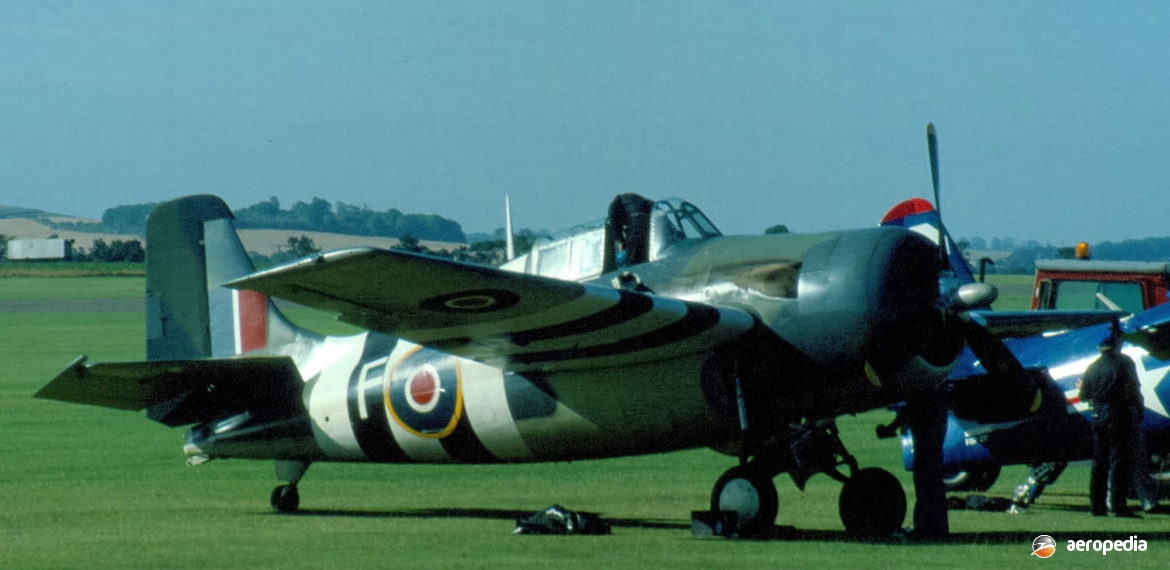Photograph:
Grumman FM-2 Wildcat N909WJ (c/n 16203) at Duxford in the United Kingdom in 1994 (David C Eyre)
Country of origin:
United States of America
Description:
Single-seat shipborne fighter-bomber
Power Plant:
One 1,007 kw (1,350 hp) Wright R-1820-56 Cyclone nine-cylinder air-cooled radial engine
Specifications:
- Wingspan: 11.58 m (38 ft)
- Length: 8.8 m (28 ft 10 5/8 in)
- Height: 3.02 m (9 ft 11 in)
- Wing area: 24.15 m² (260 sq ft)
- Max speed at 8,778 m (28,800 ft): 534 km/h (332 mph)
- Max speed at sea level: 492 km/h (306 mph)
- Economical cruising speed: 264 km/h (164 mph)
- Initial rate of climb: 1,112 m/min (3,650 ft/min)
- Service ceiling: 11,400 m (37,400 ft)
- Range: 1,448 km (900 miles)
- Max range: 2,092 km (1,300 miles)
- Empty weight: 2,471 kg (5,448 lb)
- Loaded weight: 3,751 kg (8,271 lb)
Armament:
Four 12.7 mm (0.5 in) Browning M-2 machine guns; two 113.4 kg (250 lb) bombs; or six 127 mm (5 in) rockets
History:
The definitive prototype of the Grumman Wildcat, known by the manufacturer as the G-36, flew for the first time on 2 September 1937 under the designation XF4F-2. Built in large numbers, the type bore the brunt of the naval air-war in the Pacific following Pearl Harbour. It continued in production until May 1943 when the Grumman production line was switched to the Hellcat, production continuing thereafter with General Motors.
Built to replace Grumman biplane types with the United States Navy (USN) and United States Marine Corps (USMC), it saw service with the Royal Navy (RN), initially being known as the Grumman Martlet, and later as the Wildcat, being fitted with the Wright R-1820-G-205A Cyclone engine, or the Pratt & Whitney R-1830-S34G Twin Wasp engine. A variety of models was produced to meet a range of requirements, including photo reconnaissance.
A Martlet I was the first American-built aircraft in Britain to shoot down a German aircraft when, on 25 December 1940, a Junkers Ju-88 was shot down over Scapa Flow in the Orkney Islands of Scotland by an aircraft of No 804 Squadron.
One F4F-3 (c/n 4048) was fitted in 1942 with Edo floats, making its first flight on 28 February 1943. However, the increased drag of the floats reduced maximum speed to 387 km/h (240 mph) at 5,882 m (19,300 ft), and plans to convert 100 aircraft to floatplane F4F-3S configuration for operation in the Pacific islands were shelved.
Although performance of the Wildcat was inferior to the Mitsubishi A6M “Zero”, it was a sturdy and reliable aircraft, and was capable of operating effectively from small escort carriers. Although production initially took place at Grumman’s Bethpage facility, because of the requirements for that plant to build the Hellcat, production was transferred to the Eastern Aircraft Division of General Motors (GM), the first GM-built aircraft flying on 1 September 1942, being designated FM-1. Essentially similar to the F4F-4, but with armament reduced from six to four machine guns, and fitted with the Pratt & Whitney R-1830-86 Twin Wasp engine, a total of 1,150 FM-1s was followed by 4,777 FM-2s, these having the Pratt & Whitney R-1830-56 engine. Production concluded in August 1945.
During 1994 the Alpine Fighter Collection at Wanaka in New Zealand indicated it was purchasing an FM-2 Wildcat (c/n 5744 – Bu Aer 86690). Formerly registered N20HA and operated as an agricultural sprayer at Phoenix, Arizona, the aircraft was displayed for some years at the United States Navy Museum at Pensacola in Florida. Although restored to airworthy condition as N49JC, and carrying the US Navy serial 51-235, it was in fact not imported.
A Wildcat, said to be from the ‘USS Lexington’, was located on Guadalcanal in the 1970s and, despite efforts to import it to Australia, it was placed in a Cultural Museum in Honiara in the Solomon Islands. It was later placed in the Vilu Military Museum 30 km away.
In 1998 a small number of wooden replica F4F Wildcats were built for a movie being produced in northern Queensland and one of the three which survived the filming was placed on display at the Sid Beck Museum at Mareeba, QLD.
In 2002 an American registered Wildcat was imported to New Zealand and displayed at the Warbirds over Wanaka event before being shipped back to the United States.
In recent years a number of Wildcats have been retrieved from Lake Michigan where they crashed during World War II, two aircraft carriers being operated on the lake for training pilots for shipboard operations. A number have been restored for museums, and others have been made airworthy. At least 44 examples of the type are known to have survived.

